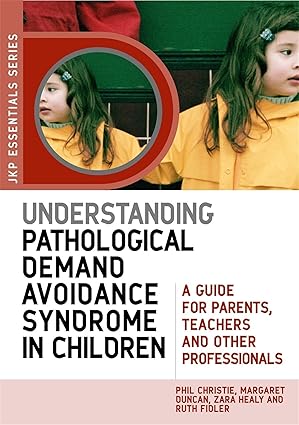Today I open up a new strand of reviews with Understanding Pathological Demand Avoidance Syndrome in Children by Phil Christie, Margaret Duncan, Ruth Fidler and Zara Healey. This is for reasons I alluded to in my review of 2024.
Pathological Demand Avoidance (PDA) is a condition first identified in children being evaluated for autism by Elizabeth Newson in the late 1970s.
The core of the PDA diagnosis is the idea that demands of a child causes them anxiety which results in a range of responses around refusing those demands, and developing strategies to avoid demand. This is a problem because often the child will refuse “demands” that would lead to things they wanted to do for example “Please put your shoes on so that we can go to the zoo” – “No!”. It also makes education and everyday life challenging.
The term did not enter the literature until around 2000, and its use has grown substantially since 2012 (see Google Ngram). This book was written around 2012. The current professional opinion on PDA appears to be that is a recordable trait for neurodivergence assessments but it is not a standalone diagnosis.
Understanding PDA is divided into 6 chapters:
- What is PDA?
- Positive Everyday Strategies – this is about managing PDA in the classroom;
- Living with PDA – this is about managing PDA at home;
- Providing the Best education for a child with PDA;
- Developing emotional well-being and self-awareness in children with PDA;
- Summing up and questions for the future;
The chapter “What is PDA?” is about diagnosis, it lists a set of diagnostic criteria and provides some examples of what these criteria look life in action. The criteria proposed for PDA are:
- Passive early history in the first year;
- Resists and avoids the ordinary demands of life;
- Surface sociability – sociability is used as a tool to avoid demands;
- Liability of mood;
- Comfortable in role playing and pretending;
- Language delay;
- Obsessive behaviour;
- Neurological involvement;
It places PDA alongside autism spectrum conditions broadly divided into “able autism” and “autism with additional learning disabilities”. Reading this I realised my son had some elements of the diagnosis but not many, I also noted that typically the children considered in this book were of primary school age – 5-10 years old. It was also a salutary reminder that our son’s behaviour is fairly mild, one parent reported being threatened by their 8 year old son with a knife! This was not the only example of violent behaviour in children.
Many parents reading this will be asking themselves whether their child fits this diagnosis, and many will be looking at the criteria and realising that they have at least some elements themselves. This presents issues in management of the condition but also provides valuable insights.
As someone with a background in physical sciences my predisposition is to see a diagnosis such as PDA as a concrete undisputable thing. However, it is better to see such diagnoses as a conversation opening to help discuss strategies for living with a child with PDA. The following chapters cover strategies for dealing with a child with PDA at home and in school. The strategies they come up with are as follows:
- Reducing demands;
- Disguising demands;
- Distraction;
- Offering choices;
- Ignoring undesirable behaviour;
- Flexibility and adaptability – learning to be willing to change plans;
- Depersonalising demands – a routine depersonalises demands;
- Staying calm and neutral – shouting can raise the “excitement” for a child, and so is something that might be sought;
- Dealing with bedtime difficulties – fortunately we don’t have these – they’re clearly a common problem;
This seems like an important section to read – it recognises that parents are not perfect and need to develop their own coping strategies. Parents also find themselves wondering where they went wrong to end in this position (they didn’t go wrong), and also feeling guilty for losing their tempers (which is common and natural). It also highlights that the impact of handling a child with PDA on other children including both siblings and class mates. Another lesson is that just because something on one day doesn’t mean it will work on another, the context and the child’s mood is important.
I found the chapter on handling PDA in school environments interesting, not for its relevance directly to me, but because government are keen on the idea of “inclusion” – teaching children on the autistic spectrum in mainstream schools. Reading the accommodations suggested for PDA pupils this seems unworkable, fundamentally because accommodations make a child stand out in a school and for children on the autistic spectrum that is something they definitely don’t want. Secondly, it is difficult to see how such approaches can be accommodated in class sizes of 30 or so typically found in mainstream schools. The authors comment that in the end success comes to the personal relationship between the child and the adult rather than any particular system.
I don’t think I would recommend this book, it is quite academic in style in a field that is not my own. It has to be seen a bit as a campaigning book for the PDA diagnosis written in 2012, so somewhat out of date. I found the National Autistic Society page on demand avoidance a useful alternative to this book. It provides a short summary of some of the key points in Understanding PDA with better context for the diagnosis’s wider, current relevance.


